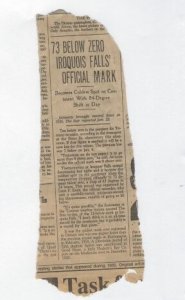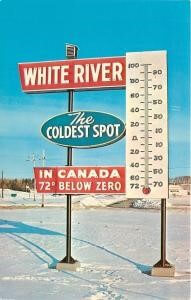
Le cas de la température la plus basse jamais enregistrée en Ontario
– Par Bryan Smith –
Quelle est la précision des données météorologiques du Canada? Le cas de la température la plus basse jamais enregistrée en Ontario laisse planer des doutes.
Les Canadiens peuvent consulter gratuitement l’une des plus importantes bases de données climatiques dans le monde, les données remontant aussi loin que 1840.
Néanmoins, malgré les efforts visant à assurer la qualité de ces données, des valeurs suspectes surgissent de temps à autre parmi les millions d’observations archivées. Les raisons expliquant l’apparition de données erronées sont nombreuses, notamment une erreur instrumentale, une erreur de l’observateur, une erreur de transcription ou une erreur non standard au cours de la procédure d’observation. Voici un aperçu de ce que je crois être l’une de ces erreurs, qui non seulement figure dans les archives depuis 85 ans, mais qui se présente aussi à l’heure actuelle comme la température la plus froide jamais enregistrée en Ontario.
La date était le 23 janvier 1935. L’emplacement était Iroquois Falls, situé à 55 km au nord-est de Timmins et à 40 km au sud de Cochrane, en Ontario.
La valeur était une température journalière minimale de moins 58,1°C (moins 73°F). L’observateur était un bénévole qualifié à l’Abitibi Paper Power Plant, une station climatologique coopérative où les observations météorologiques quotidiennes étaient relevées depuis 1913. Cette température minimale battait censément l’ancien record minimum de 57,6°C observé à Hornepayne en février 1918.
Toutefois, selon des comparaisons spatiales, il est fort probable que cette marque d’Iroquois Falls soit une erreur. Qui plus est, il s’est avéré que le record minimum original de Hornepayne observé en février 1918 était aussi erroné, d’où sa suppression des archives.
La question subsiste quant à la température la plus froide jamais enregistrée en Ontario. Il vaut peut-être mieux laisser le soin à Environnement et Changement climatique Canada de mettre à profit leur savoir et leur puissance de calcul pour revoir toutes les données les plus froides afin de mettre les choses au point. Les records sont faits pour être battus, mais il arrive parfois que les raccords battus doivent être corrigés.
How accurate are Canada’s weather records? The case of Ontario’s all-time record low temperature casts some doubt.
Canadians have free access to one of the most extensive climate databases in the world with data going back to 1840. However, despite efforts to quality-assure this data, suspicious values emerge from time to time among the millions of archived observations. The reasons for the occurrence of inaccurate data are numerous,
including: instrument error, observer error, transcription error or non-standard observing procedural error. This is a look at what I believe to be one of these errors – one that has not only existed in the archive for 85 years, but also currently stands as Ontario’s all-time coldest minimum temperature.

The date was January 23, 1935. The location: Iroquois Falls, located 55 km northeast of Timmins and 40 km south of Cochrane, ON.
The value was a minus 58.°1 C (minus 73°F) minimum daily temperature. The observer was a trained volunteer at the Abitibi Paper Power Plant – a co-operative climate station where daily weather observations had been taken since 1913. This minimum temperature allegedly broke the former record low of minus 57.6°C set in Hornepayne in February 1918.
However, based on spatial comparisons, it very likely that this Iroquois Falls mark is in error. As well, the original February 1918 Hornepayne record low was later shown to be in error itself and was removed from the archive.
Daily Minimums for January 1935 in Northeastern Ontario: A Spatial Comparison
The graph below (Fig. 3) shows the low temperatures each morning for the climate stations in Northeastern Ontario. Note that Iroquois Falls was only the coldest low on January 23. Every morning except January 23 was colder at other locations in northeastern Ontario. The January 23 minimum temperature in Iroquois Falls was very much an anomaly with a reading approximately 20 degrees Celsius colder than Timmins.
Using an average difference calculation on the minima for January 1935 comparing Iroquois Falls, Timmins and Cochrane, the following statistics were found:

While Iroquois Falls is on average colder than either Timmins or Cochrane, when the average difference is applied to the Iroquois Falls minimum for January 23; the adjusted Iroquois Falls temperature fits much better into the pattern for that morning. For example the average difference minimum temperature for the month of January 1935 was:
- Iroquois Falls 7.4°C degrees colder than Timmins
- Iroquois Falls 3.7°C degrees colder than Cochrane
Applying these average differences to the Iroquois Falls morning low on January 23, it is much more likely that the minimum Iroquois Falls temperature should have been closer to minus 46 degrees C rather than minus 58 degrees C.
Annual Minimum Temperatures in North Eastern Ontario 1920-1940
The second graph (Fig. 4) shows annual extreme minimum temperatures in northeastern Ontario from 1920 to 1940. Again Iroquois Falls is the coldest extreme minimum only in 1935, a value that is certainly an anomaly during this 20 year period. Only once in the entire history of weather observing (1913-1998) at Iroquois Falls did a temperature less than minus 50°C occur and that was on the date of the alleged record low.
Note that the White River climate station was most often the coldest locale by year. White River however experiences cold air drainage as it sits in a broad river valley with 100 metre hills all around. The siting of the Iroquois Falls climate site was not unusual. It was sited north of the large Abitibi paper mill near a parking lot with sloping ground to the river 300 metres away.

(Right) Figure 4. Annual extreme minimum temperatures for towns in the Northeastern region of Ontario.
Correcting record temperatures has been a fairly common occurrence for provinces, nations, and US states. J.G.Potter (1966, p. 36) in his paper “The Highest Temperature in Canada ?” published in 1966 stated that “it is impossible to thoroughly check the accuracy of any reported extreme values in the early records”. For example in Ontario the record maximum temperature was at one time considered to be a 42.8°C maximum at Stonecliffe northwest of Pembroke. This value was subsequently found to be in error and corrected to 37.8°C. Similar decisions were made regarding Canada’s highest temperature once considered to be 46.1°C set at Gleichen, Alberta in July 1903. The replacement record high was thought to be 45.6°C. recorded at Lundbreck Alberta but this too was shown by spatial comparison to likely be 10°F degrees too high.
In the USA their oldest state record was Colorado’s maximum value at Bennett, set in 1888. A review by T.W. Bettge published in Weatherwise 1985 found this to be an erroneous reading.
Extreme weather records are a fascination for people interested in the hottest, coldest, driest and wettest areas in a province or nation. Towns often leverage these facts to draw attention. Anyone who has driven the scenic highway between Sault Ste. Marie and Thunder Bay has seen the famous White River record temperature sign. Granted White River is a very cold winter spot as shown in Figure 4, but the claim as Canada’s coldest town at minus 73°F (minus 58°C) is not true. Snag in the Yukon owns this record with a minus 63°C value. However this long-standing giant thermometer illustrates the interest people have in such all-time records.

Accordingly if the Iroquois Falls record low is discounted, what is the coldest recorded temperature in Ontario?
There are several contenders as listed in G.R. Kendall’s paper “The Coldest Place in Ontario” published in 1964.
The list includes:
- Central Patricia (located 450 km north of Thunder Bay and 5 km northeast of Pickle Lake) -53.9°C January 5, 1959.
- Hornepayne -52.8°C Jan 23, 1935
- White River -51.7°C Jan 23, 1935.
- Ingolf -51.2°C Feb 7, 1933.
- Franz -50.6°C Jan 23, 1935.
- Armstrong -50.0°C Jan 29, 1957.
Note that the January 23, 1935 date (same as the Iroquois Falls reading) is the coldest day at several stations and for this reason that date may well be the coldest day in Ontario. Although Central Patricia looks like an obvious choice, the low temperature at nearby Pickle Lake on January 5, 1959 was only minus 46.7°C (allowing for the time difference in observing programs). This temperature difference of 7.2°C degrees over such a short distance looks excessive and casts some doubt on the Central Patricia reading.
The question remains as to Ontario’s coldest ever recorded temperature. Perhaps it is best left to Environment and Climate Change Canada to use their knowledge and computing power to review all the coldest candidates to set the record straight. Records are made to be broken, but sometimes broken records need to be fixed.
Finally as alluded to earlier, this paper is a reminder that all data, even Canada’s, needs to be used with some degree of caution.
References
- Bettge, T. W. (1985). Weather records: The case of the Bennett, Colorado maximum temperature. Weatherwise, 38:2, 95-97. doi:10.1080/00431672.1985.9933292
- Kendall, R.G. (1964). The Coldest Place in Ontario, CDS #3-64 published July 31 1964 Dept. of Transport Meteorological Branch Climatology Division
- Potter, J.G. (1966) The highest temperature in Canada ?, Atmosphere, 4:3,29-37, DOI: 10.1080/00046973.1966.9676527
About the Author

Bryan graduated from York University and Waterloo back in the last Century. He was Superintendent of the Ontario Climate Centre from 1986 until his retirement in 2005. Following retirement he founded Forensic Weather Services; a consultation service for the legal and law enforcement sectors. Bryan was a volunteer climate observer from 1981 to 2009 (Sandhill-Caledon). Publications include “The Climate of Toronto” (with Auld, Loiselle, Allsopp), “Climatology Goes to Court” and “The Changing Climate of Orangeville”. Bryan and his wife divide their time between a home in Orangeville and a log cabin on the Muskoka River.
Avez-vous aimé cet article? Abonnez-vous ici pour recevoir plus du SCMO!
Plus comme ceci
Bryan Smith, données météorologiques du nord de l'Ontario, température la plus basse jamais enregistrée